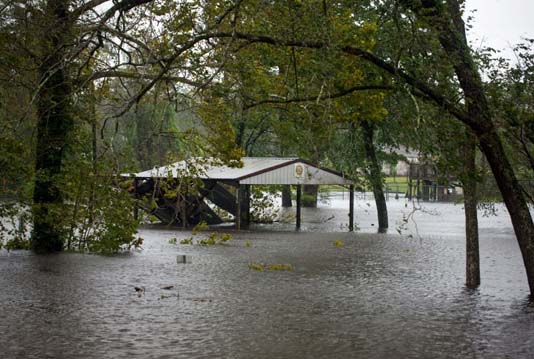GRIFTON, United States, Sept 17, 2018 (BSS/AFP) – Catastrophic floods
raised the threat of dam breaks and landslides across the southeastern United
States on Sunday, prolonging the agony caused by a killer hurricane that has
left more than a dozen people dead and billions of dollars in damage.
Downgraded to a tropical depression, Florence slowly crawled over South
and North Carolina, dumping heavy rains on already flood-swollen river basins
that authorities warned could bring more death and destruction.
“A lot of people have evacuated already,” said Denise Harper, a resident
of Grifton, a small North Carolina town threatened by rising water levels in
a nearby creek and the River Neuse. “It’s worrying to watch the water slowly
rising.”
At least 15 people have died since Florence made landfall Friday as a
Category 1 hurricane near Wrightsville Beach, 10 in North Carolina and five
in South Carolina.
“Unfortunately we’ve still got several days to go,” Brock Long,
administrator of the Federal Emergency Management Agency, told Fox News.
Long said more havoc lays ahead as the storm broadens its geographic scope
over regions deeply saturated with water.
Of particular concern were the risks to dams, already stressed by heavy
rainfall from a tropical storm earlier in the month, he said, urging citizens
to heed official warnings about what was now a “flood event.”
“What we have to focus on are there any dams that are going potentially
going to break.”
“People fail to heed warnings and get out or they get into the flood
waters trying to escape their home. And that’s where you start to see deaths
escalate,” he told CBS News.
“Even though hurricanes are categorized by wind, it’s the water that
really causes the most loss of life.”
A dull, leaden sky hung over Grifton on Sunday. Days of heavy rainfall
have turned the surrounding farmland into soggy marshland.
Forty miles to the south, the tiny town of Pollocksville, population 300,
found itself cut in two on Sunday afternoon after the River Trent burst its
banks.
– Electrocution risk –
With the rain pausing for the first time since Friday, local resident
Logan Sosebee pulled out his kayak to carry food and supplies to those who
need it on the other side of the flooded river.
“We still have no water and power, so I’m happy to help if I can, there’s
nothing else to do,” he said. “But the current is crazy.”
“The water… has gone up 10-15 feet (3 to 4.5 meters) in a few days and
it’s supposed to keep rising for a few days. I’m a bit worried for my home.”
North Carolina Governor Roy Cooper earlier told reporters “the strongest
storm bands are dumping two to three inches of rain (5 – 7.5 centimeters) per
hour” over regions that had already received up to two feet of rain.
“That’s enough to cause flooding in areas that have never flooded before
until now. The risk is growing as well in the mountains, where rains could
lead to dangerous landslides,” he said.
A woman and her baby were among the storm’s first casualties when a tree
fell on their house. Others killed included three who perished “due to flash
flooding and swift water on roadways,” according to the Duplin County
Sheriff’s Office, and a 61-year-old woman who died when her car hit a downed
tree.
At least two people died from electrocution while attempting to connect
their generators, while one couple died of monoxide poisoning from running
their generator indoors.
– ‘Billions’ in damage –
Even as some residents began returning to their homes, officials warned of
a long road to recovery ahead.
“I think that the storm is likely going to produce impacts greater than
Hurricane Matthew,” Senator Thom Tillis of North Carolina said on Fox News,
referring to a Category 5 storm that struck in 2016, killing 26 in the state.
“The agriculture industry, the largest industry in our state is hard-hit.
We will have to sort out the crop damage,” he continued, adding: “I think
that it’s fair to say in terms of economic impact rebuilding that we are
talking in the billions of dollars.”
The number of customers without power across North Carolina fell to just
under 500,000, with about 20,000 in South Carolina. Fifteen thousand
meanwhile were being housed in 158 shelters across the state.
“Three days of relentless rain from #Florence has resulted in significant
flooding in #NC #SC,” said Duke Energy, a major power supplier. “Driving is
treacherous and flooding is impacting our ability to restore power. Flooding
can also conceal downed power lines.”
US Coast Guard Commandant Admiral Karl Schultz told ABC 28 aircraft had
been deployed as well as 35 “shallow water rescue teams.”
Some 2,800 North Carolina National Guardsmen were actively aiding rescue
and relief efforts Sunday with another 1,000 on standby.



